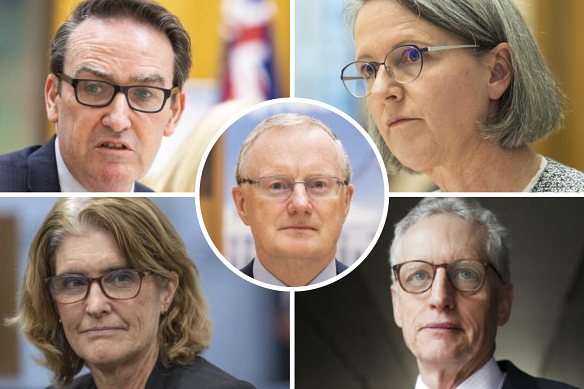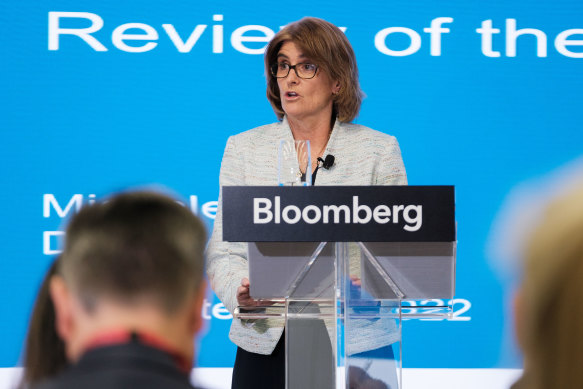Save articles for later
Add articles to your saved list and come back to them any time.
A handful of candidates from outside the Reserve Bank, including Treasury secretary Steven Kennedy, are in the running to replace governor Philip Lowe as the institution braces for an overhaul of its culture and the way it sets interest rates.
Kennedy, Finance Department secretary Jenny Wilkinson, Australian Bureau of Statistics head David Gruen and current bank deputy Michele Bullock are among those being considered, along with monetary policy experts from overseas, according to multiple sources who are not authorised to speak publicly.
There are several candidates believed to be in the race to replace Reserve Bank governor Philip Lowe (centre). Pictured clockwise from top left are: Treasury secretary Steven Kennedy, Finance Department secretary Jenny Wilkinson, current RBA deputy Michele Bullock, and Australian Bureau of Statistics head David Gruen.Credit: Alex Ellinghausen, Eamon Gallagher
Treasurer Jim Chalmers on Thursday confirmed he would decide on the governor’s position in July as he races to put in place major changes to the bank recommended by the recent RBA review, including a new agreement on how it targets inflation.
Lowe’s seven-year term is due to end in early September. His two immediate predecessors, Glenn Stevens and Ian Macfarlane, had their terms extended by three years, making them the first governors to helm the bank for more than seven years since the 1960s.
But Lowe’s handling of monetary policy before the COVID-19 pandemic, his communication of interest rate movements over the past 18 months, the review findings and criticism of the bank by the public and Labor backbenchers have raised doubts about whether his term will be extended.
A recent Resolve Political Monitor survey for this masthead found 52 per cent of Australians think Lowe should lose his job.
Traditionally, the RBA deputy governor has become the governor. New governors have also usually had a long pedigree working within the bank.
Bullock, the bank’s first female deputy governor who assumed the role last year and has been at the RBA since 1985, would ordinarily be the frontrunner.
But the RBA review, outside its proposals for major changes to how interest rates are set, noted that the bank needed substantial cultural change.
“RBA’s leaders have undertaken many initiatives over recent years to make the RBA a more open and dynamic institution that is well-equipped to support its staff and carry out its duties. Yet, there remains a gap in the lived experience of staff members,” the review found.
“The RBA’s leaders should adopt behaviours to demonstrate the changes the organisation should seek to achieve.”
That has pushed the government to consider someone from outside the RBA to take the reins from Lowe.
Kennedy, who sits on the RBA board as Treasury secretary, was described as the standout candidate by one monetary policy expert who spoke on condition of anonymity.
They said Kennedy’s experience helming various government departments meant he understood the importance of leading change within a large bureaucracy while also being a top-quality economist.
Reserve Bank of Australia deputy governor Michele Bullock.Credit: Oscar Colman
The last bank “outsider” to be made governor was then-Treasury secretary Bernie Fraser in 1989. That decision upset elements of the bank, including senior executives who were in line to be promoted after Bob Johnston’s term as governor ended.
Wilkinson, who was made Finance Department secretary last year, is also under serious consideration. She has held various economic roles in the federal bureaucracy and has also worked at the RBA.
Her husband, David Gruen, has long been considered one of the country’s best economists. He took over as head of the ABS in December 2019 and drove the bureau’s rapid changes to help measure the impact of the pandemic on the economy.
US-based Australian economist Justin Wolfers has been discussed, but is considered more likely to be appointed to the new monetary policy committee that will set interest rates under the looming RBA restructure.
A key consideration for Chalmers is the statement on the conduct of monetary policy, which contains the bank’s 2 to 3 per cent inflation target and is signed between the bank’s governor and the treasurer of the day.
The review says a new statement needs to be signed by the end of this year.
The statement has not been updated since it was put in place by then-treasurer Scott Morrison and Lowe soon after his appointment as governor in 2016. While similar to previous agreements, the Morrison-Lowe agreement directly linked the bank’s inflation target to the broader objective of financial stability.
Critics have since claimed the inclusion of financial stability meant the RBA was worried about reducing interest rates ahead of the pandemic out of concern it would push up property prices.
While there has been discussion about extending Lowe’s term for a few months to bed down reforms to the bank, this masthead has been told it makes little sense for Chalmers to strike an agreement with a governor who will not be in place to oversee its long-term implementation.
Chalmers said he was consulting his cabinet colleagues about the governor’s position, and made it clear whoever held the job would have to deal with the RBA review.
“Obviously, the Reserve Bank governor needs to be well-placed to implement the recommendations of the review and to take the Reserve Bank into the future,” he told ABC radio.
“There are all of the usual considerations in that – a person of credibility, a person with experience, and a person able to take the Reserve Bank forward.”
Cut through the noise of federal politics with news, views and expert analysis from Jacqueline Maley. Subscribers can sign up to our weekly Inside Politics newsletter here.
Most Viewed in Politics
From our partners
Source: Read Full Article




